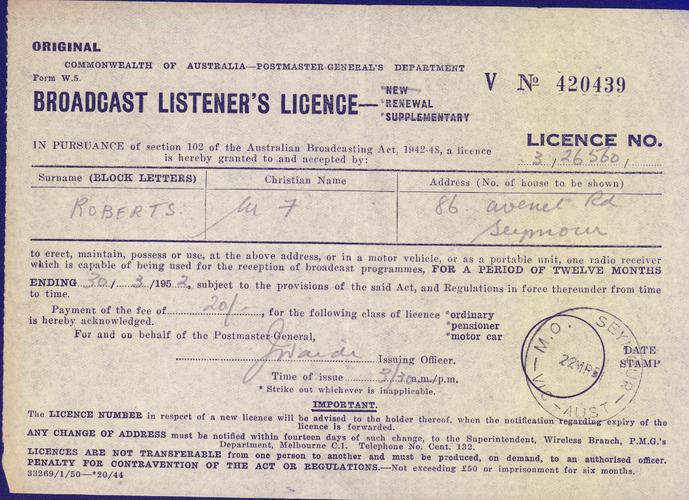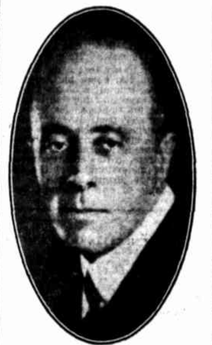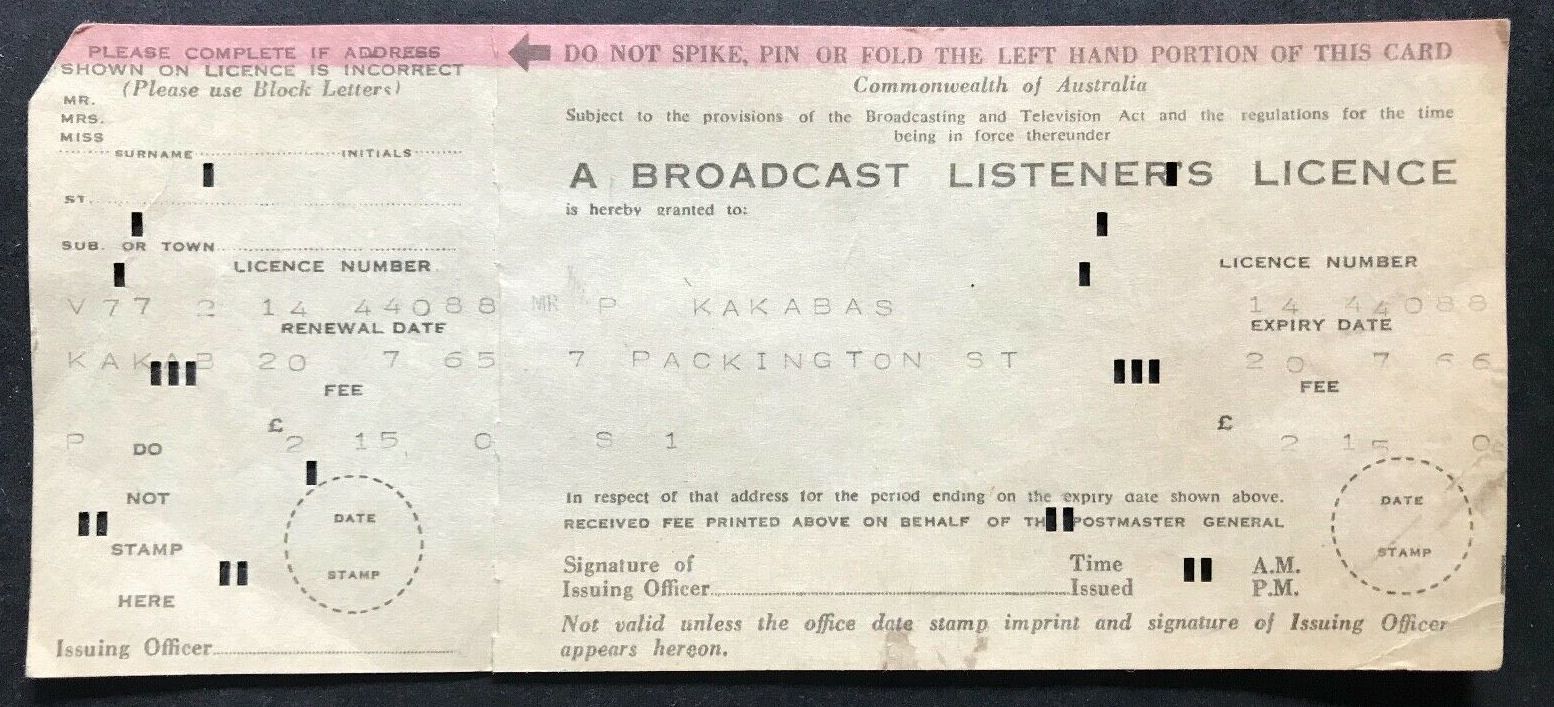BROADCAST LISTENERS LICENCE.
The first radio broadcast in Australia was on the 13th day of August 1919, when Ernest Fisk of Amalgamated Wireless Australia (AWA) arranged for the broadcast of the Australian National Anthem 'God Save the Queen' from one building to another at the end of a lecture he had presented to the Royal Society of NSW at 5 Elizabeth Street, Sydney.
The transmitted was a single valve AWA constructed transmitter which was located at Wireless House at 97 Clarence Street, Sydney. The signal travelled about 100 years, with 20 telephone earpieces with tin horns attached which were hung from the ceiling as loudspeakers.
The transmitted was a single valve AWA constructed transmitter which was located at Wireless House at 97 Clarence Street, Sydney. The signal travelled about 100 years, with 20 telephone earpieces with tin horns attached which were hung from the ceiling as loudspeakers.
Above:- E.T. Fisk. Image c/o Trove.
Led by Fisk of AWA, the Australian radio manufacturing industry lobbied the Australian Commonwealth Government for the introduction of radio broadcasting. In May 1923 a conference was held in Melbourne which was attended by wireless manufacturers, retailers, broadcasters, listeners, and experimenters.
The conference led to the 'Sealed Set Regulations'. Radio stations were to be licenced to broadcast and then sell sets to 'listeners-in'. However, the radio set, or wireless as they were more commonly known, would be set to receive only that station.
The conference led to the 'Sealed Set Regulations'. Radio stations were to be licenced to broadcast and then sell sets to 'listeners-in'. However, the radio set, or wireless as they were more commonly known, would be set to receive only that station.
Above:- newspaper article from the Daily Telegraph, 23rd November 1923. Image c/o Trove.
Commercial radio broadcasts commenced in Australia in 1923. Radio 2FC in Sydney was the first to be licenced on the 1st day of July 1923.
However, broadcast licence number 3, radio 2SB (to become 2BL) was the first public radio station in Australia to go to air. It commenced broadcasting at 8.00 p.m. on the 23rd day of November 1923. The number 2 denoted New South Wales, while SB stood for Broadcasters Sydney Limited.
Broadcast Licence number 1, 2FC went to air on the 5th day of December 1923.
Only four stations commenced operation under the sealed system: Broadcasters Sydney Ltd 2SB, Farmers and Company 2FC Sydney, Associated Radio Company 3AR Melbourne, and Westralian Farmers Ltd 6WF Perth.
A wireless was regulated at purchase to the wavelength of a particular radio broadcaster. Listeners paid a subscription fee to listen to that particular radio station. In 1923 the subscription fee was 3 pounds 3 shillings, with an additional licence fee of 10 shillings which was payable to the Postmaster General's Department.
The 'Sealed Set Scheme' was not accepted by listeners, with only 1,400 listeners obtaining licences between August 1923 and June 1924.
However, broadcast licence number 3, radio 2SB (to become 2BL) was the first public radio station in Australia to go to air. It commenced broadcasting at 8.00 p.m. on the 23rd day of November 1923. The number 2 denoted New South Wales, while SB stood for Broadcasters Sydney Limited.
Broadcast Licence number 1, 2FC went to air on the 5th day of December 1923.
Only four stations commenced operation under the sealed system: Broadcasters Sydney Ltd 2SB, Farmers and Company 2FC Sydney, Associated Radio Company 3AR Melbourne, and Westralian Farmers Ltd 6WF Perth.
A wireless was regulated at purchase to the wavelength of a particular radio broadcaster. Listeners paid a subscription fee to listen to that particular radio station. In 1923 the subscription fee was 3 pounds 3 shillings, with an additional licence fee of 10 shillings which was payable to the Postmaster General's Department.
The 'Sealed Set Scheme' was not accepted by listeners, with only 1,400 listeners obtaining licences between August 1923 and June 1924.
Above:- Newspaper article dated September 1924. Image c/o Trove.
By July 1924, new regulations governing wireless broadcasting in Australia were announced by the Prime Minister Stanley Bruce. It involved two groups of stations - Class A and Class B.
Class A stations received revenue from the licence fees paid by listeners and from some limited advertising. While all revenue for Class B stations came from advertising.
The "A" class stations were the original sealed set stations, plus one in each other capital city - 2BL, 2FC, 3AR, 3LO, 7ZL, 5CL, and 6WF.
The first Class B station on air was Burgin Electric Company Ltd 2BE in November 1924. The oldest surviving Class B station is 2UE which went on air on the 26th day if January 1925.
By the end of 1924 the number of listener licences was nearly 40,000. Towards the end of 1925 it had doubled to about 80,000.
Class A stations received revenue from the licence fees paid by listeners and from some limited advertising. While all revenue for Class B stations came from advertising.
The "A" class stations were the original sealed set stations, plus one in each other capital city - 2BL, 2FC, 3AR, 3LO, 7ZL, 5CL, and 6WF.
The first Class B station on air was Burgin Electric Company Ltd 2BE in November 1924. The oldest surviving Class B station is 2UE which went on air on the 26th day if January 1925.
By the end of 1924 the number of listener licences was nearly 40,000. Towards the end of 1925 it had doubled to about 80,000.
From as early as 1925, complaints about the cost of licences commenced to appear in newspapers.
In 1925 a Brighton Victoria Justice of the Peace made comments after fining people for not paying the 'listening-in' licence fee. He expressed regret that such a high amount had been fixed and stated that it 'tended to discourage experiments in wireless'. He further stated 'after all, it was better for young people to be at home at night with their wireles plants than walking the streets'.
In response the Postal Director said that from a business point of view everyone needed to realise that it was essential to obtain adequate revenue from the licence fees, otherwise it would not be possible to maintain the service.
In 1925 a Brighton Victoria Justice of the Peace made comments after fining people for not paying the 'listening-in' licence fee. He expressed regret that such a high amount had been fixed and stated that it 'tended to discourage experiments in wireless'. He further stated 'after all, it was better for young people to be at home at night with their wireles plants than walking the streets'.
In response the Postal Director said that from a business point of view everyone needed to realise that it was essential to obtain adequate revenue from the licence fees, otherwise it would not be possible to maintain the service.
Above:- newspaper article from The Age Melbourne, Saturday 28th February 1925. Image c/o Trove.
Nearly 300,000 radio receiver licences had been issued in Australia by the end of 1929. This was about 4.7% of a population of about 6,400,000. This equated to about 20% of households in Australia.
By the end of 1938, a total of 1,102,315 radio receiver licences had been issued in Australia. This was about 16% of a population of about 7,000,000, or 66% of households.
Despite the increase in the uptake of licences, Radio Inspectors often prosecuted those who did not have a licence. A conviction could result in a 20 pound fine. This was very onerous considering the average weekly wage in the 1930s was about 14 pounds.
By the end of 1938, a total of 1,102,315 radio receiver licences had been issued in Australia. This was about 16% of a population of about 7,000,000, or 66% of households.
Despite the increase in the uptake of licences, Radio Inspectors often prosecuted those who did not have a licence. A conviction could result in a 20 pound fine. This was very onerous considering the average weekly wage in the 1930s was about 14 pounds.
Over the years the listeners licence underwent various changes relating to cost and the classes of use.

Above:- A Broadcast Listeners Licence from 1952. Image c/o https://collections.museumsvictoria.com.au/articles/15789
With the introduction of television in Australia in September 1956, a viewer licence was introduced. By 1957 TV viewers were required to pay 5 pounds and an additional 2 pounds 15 shillings for radio. A fine of up to 50 pounds could be imposed on those who did not comply.
Above:- a Broadcast Listeners Licence from 1965. Image c/o ebay.com.au.
During the 1950s the Post Master General placed advertisements in newspapers around Australia warning residents that visits from PMG officials may occur.
To avoid the fines, many people hid their radio and TV antennas in attics and chimneys, while radio and television receivers were often hidden in cupboards.
Officials were reported to use devices to measure RF frequencies generated by radio equipment. Listeners often resorted to using crystal sets which did not require electricity to operate and were unable to be detected.
Officials were reported to use devices to measure RF frequencies generated by radio equipment. Listeners often resorted to using crystal sets which did not require electricity to operate and were unable to be detected.
Above:- Advertisement from the Canberra Rimes, October 1958.
During the 1950s and 1960s, the Post Master General ran numerous advertisements reminding the public of their responsibility to ensure they had a radio and TV licence. The advertisement below features Australian actor Frank Thring (b. 1926 - d. 1994).
The Brits also had to pay for a TV licence. I found the advertisement below featuring John Cleese to be very funny.
By the 1970's a combined TV and radio licence could be purchased in Australia at a cost of $26.50.
Above:- A Combined Receiving Licence from 1973. Image c/o ebay.com.au
On the 18th day of September 1974 the Australian Federal Whitlam Government abolished radio and TV licences. The Australian Broadcasting Corporation (ABC) which had been financed by the licence fees, was then funded by Australian taxpayer revenue.
An attempt was made to reintroduce listener/viewer licences in 1975 by the Australian Fraser Government. Recommended fees of $70.00 for a colour television and $50.00 for a black and white television set were met with huge opposition, and the proposal did not proceed.
An attempt was made to reintroduce listener/viewer licences in 1975 by the Australian Fraser Government. Recommended fees of $70.00 for a colour television and $50.00 for a black and white television set were met with huge opposition, and the proposal did not proceed.
References.
1. Australian Old Time Radio, 2021, <https://www.australianotr.com.au/radio-receiver-licences.html>, viewed 28th June 2021.
2. Australian Old Time Radio, 2021, <https://www.australianotr.com.au/australias-first-radio-broadcasts.html>, viewed 29th June 2021.
3. Langhans, R, 2013, 'The First Twelve Months of Radio Broadcasting in Australia 1923-1924'
4. The History of Australian Radio, 2021, <https://media.adelaide.edu.au/radio/intro/history_OZ-radio.pdf>, viewed 29th June 2021.
5. Museums Victoria, 2021, <https://collections.museumsvictoria.com.au/articles/12666>, viewed 30th June 2021.
6. NFSA, 2021, <https://www.nfsa.gov.au/latest/radio-and-tv-licences>, viewed 28th June 2021.
7. Trove, 2021, <https://trove.nla.gov.au/>, viewed 30th June 2021.
8. Wikipedia, 2021, <https://en.wikipedia.org/wiki/ABC_Radio_Sydney>, viewed 29th June 2021.






